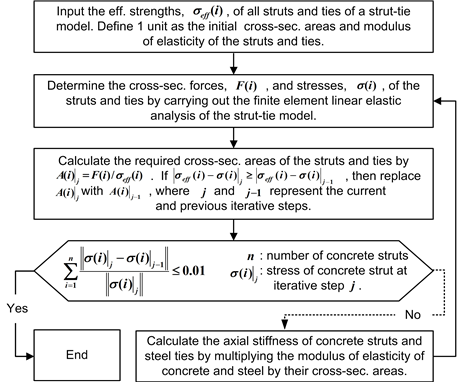For a given load combination, a two-dimensional finite element model for evolutionary structural optimization, compressive principal stress flows, truss structure, or nodal zone can be selected in the Modeling Mode. This menu does not function in the Beginning Mode.




The cross-sectional areas of struts and ties in a strut-tie model are determined by a simple optimization technique when the Optimized Area is selected. When the Fixed Area is picked, the cross-sectional areas of struts and ties must be assigned.

After the structural analysis of constructed strut-tie model, the design results regarding the strength verification of struts, ties, and nodal zones (smeared node) can be reviewed.

After the structural analysis of constructed strut-tie model, the design results of nodal zone (concentrated node) can be checked visually. Concentrated nodes are likely to fracture compared to smeared node, so detailed check is needed.

A concrete member is designed by using the strut-tie model method when the Design Mode is clicked. On the other hand, the ultimate strength and behavior of a concrete member are evaluated by the strut-tie model method when the Analysis Mode is selected. In the Analysis Mode, the amount of reinforcement placed in a concrete member must be transformed to the cross-sectional areas of steel ties of strut-tie model.

- Technical Reference
1. Analysis Mode versus Design Mode
‘Analysis Mode’ is a function for safety evaluation of structural concrete whose construction is completed.
If you select ‘Analysis Mode’, AStrutTie performs the analysis of truss model after fixing the cross-sectional area of tie.
Because, for structures that have already been constructed, the reinforcement is already arranged.
At this time, the cross-sectional area of tie is determined by property of reinforcement defined by [DEFINE_Tie Types] menu.
On the other hand, in the ‘Design Mode’, AStrutTie performs the analysis of truss model without fixing the cross-sectional area of tie.
2. Fixed Area versus Optimized Area
The cross-sectional forces of elements (struts and ties) in the statically determinate strut-and-tie model are determined regardless of the axial stiffness (EA) of elements.
On the other hand, the cross-sectional forces of struts and ties in the statically indeterminate strut-and-tie model depend on the axial stiffness of struts and ties.
Therefore, to analyze the statically indeterminate strut-and-tie model, the required cross-sectional areas of struts and ties shall be rationally determined.
In the ‘Optimized Area’ mode, the required cross-sectional areas of struts and ties are determined through a method utilizing a simple iterative technique.
This technique determines the required cross-sectional areas according to the following procedure.

On the other hand, in the ‘Fixed Area’ mode, the cross-sectional areas of struts and ties are fixed by the value entered in the [ASSIGN_Fixed Area] menu.
3. Stress Flow and ESO Analysis
1) Stress Flow Analysis
The strut-and-tie model approaches of current design codes suggest that structural designers locate the struts and ties based on the load path method so that the load transfer mechanism in structural concrete can be reflected properly according to the elastic stress trajectories.
The ‘Stress Flow Analysis’ is a function to verify elastic stress trajectories of structural concrete. In order to construct an optimal strut-and-tie model, the axis of struts shall be matched as much as possible in the direction of compressive principal stress.
2) ESO Analysis
Evolutionary Structural Optimization (ESO) technique is the way to derive the optimal structure shape by eliminating unnecessary parts of the structure. The features of this method is explained in the links below.
http://astruttie.aroad.co.kr/index.php/2016/03/17/evolutionary-structural-optimization-method-e-s-o/
In conclusion, both methods are the tools for constructing the appropriate strut-and-tie model. These functions are recommended for use as a reference when the construction of a strut-and-tie model is difficult.